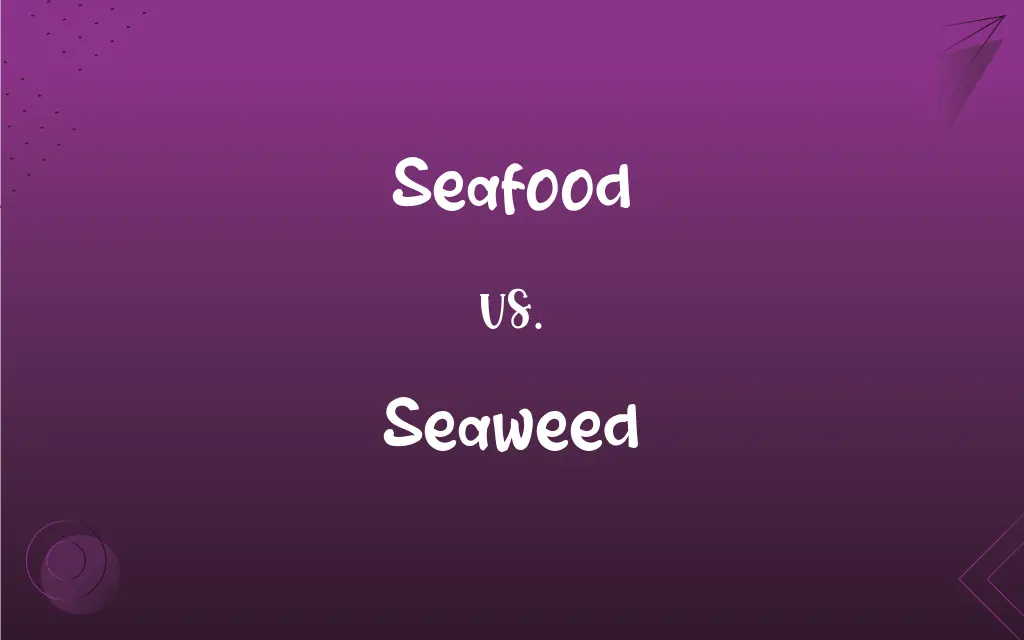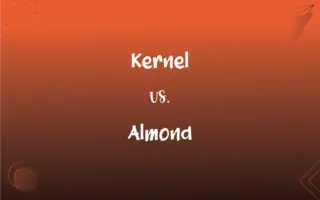Seafood vs. Seaweed: What's the Difference?
Edited by Aimie Carlson || By Janet White || Updated on October 27, 2023
Seafood is marine animals, like fish and shellfish, eaten by humans; seaweed is marine algae, often used in food or skincare.

Key Differences
Seafood encompasses any form of marine life regarded as food by humans. This includes fish and shellfish, encompassing numerous species of mollusks, crustaceans, and echinoderms. Essentially, seafood represents a diverse range of flavors, textures, and culinary experiences, stemming from the vastness of marine life. Seaweed, in contrast, refers specifically to certain species of marine algae. It's not an animal but a plant-like organism, which also offers nutritional benefits and is particularly prominent in various cuisines, especially in Asian dishes.
Seafood is primarily known for its high protein content, often recommended for a balanced diet due to its omega-3 fatty acids and low saturated fats. Its consumption is globally ubiquitous, with fishing industries worldwide harvesting a variety of seafood from the oceans, rivers, and lakes. Seaweed, while not as universally consumed, holds its own nutritional benefits, including vitamins, minerals, and antioxidants, and is a dietary staple in many coastal regions.
The harvesting of seafood is an age-old practice, deeply ingrained in many cultures and cuisines, providing livelihoods for millions globally. Overfishing and environmental concerns, however, have raised questions about the sustainability of certain seafood sources. Seaweed cultivation, on the other hand, is seen as highly sustainable, often requiring fewer resources compared to other forms of agriculture, and even offering environmental benefits, such as carbon sequestration and habitat restoration.
In culinary applications, seafood is incredibly versatile, featured in countless dishes from simple seared fish to elaborate seafood platters. Its preparation can vary widely among different cultures and cooking techniques. Seaweed, though not as diverse in preparation, is prized for its unique flavors and is often used in soups, salads, and sushi or processed into snacks and supplements.
While seafood allergies are relatively common and can cause severe reactions, seaweed is generally considered hypoallergenic, although it's not entirely exempt from causing adverse reactions in individuals with specific sensitivities. Both seafood and seaweed, however, are integral to the culinary world, offering a range of flavors and health benefits.
ADVERTISEMENT
Comparison Chart
Type
Marine animals
Marine algae
Nutritional Content
High in protein, omega-3s
Rich in vitamins, minerals
Sustainability
Concerns over overfishing
Considered highly sustainable
Culinary Use
Diverse preparations
Used in specific dishes, dietary supplements
Allergies
Common seafood allergies
Generally hypoallergenic
ADVERTISEMENT
Seafood and Seaweed Definitions
Seafood
Seafood refers to both saltwater and freshwater organisms consumed by humans.
The restaurant by the bay offers a wide variety of fresh seafood.
Seaweed
Seaweed is a type of marine algae found in oceans and suitable for consumption or use in products.
The sushi roll is wrapped in a thin layer of seaweed.
Seafood
Seafood is any edible marine life, including fish and shellfish.
We're having a seafood feast tonight with shrimp, scallops, and salmon.
Seaweed
Seaweed refers to various species of macroscopic, multicellular, marine algae.
We collected different types of seaweed along the shoreline.
Seafood
Seafood encompasses a diverse range of edible aquatic life forms.
I love trying exotic seafood when I travel to coastal regions.
Seaweed
Seaweed is known for its high content of vitamins, minerals, and dietary fiber.
I incorporate seaweed into my diet for its nutritional value.
Seafood
Seafood is a protein-rich food source known for its health benefits, particularly omega-3 fatty acids.
My diet consists mainly of vegetables and seafood.
Seaweed
Seaweed is harvested for use in food, medicine, cosmetics, and as a fertilizer.
The skincare range uses seaweed extract for its hydrating properties.
Seafood
Seafood is often harvested from the wild or farmed in aquaculture operations.
Sustainable seafood practices ensure there's plenty for future generations.
Seaweed
Seaweed cultivation is an environmentally friendly and sustainable practice.
The seaweed farm contributes to local biodiversity.
Seafood
Edible fish or shellfish from the sea.
Seaweed
Any of numerous marine algae, such as a kelp, rockweed, or gulfweed.
Seafood
Fish, shellfish, seaweed, and other edible aquatic life.
Seaweed
A mass of such algae.
Seafood
Edible fish (broadly including freshwater fish) or shellfish or roe etc
Seaweed
Any of numerous marine plants and algae, such as a kelp.
Seaweed
(by extension) Any of various fresh water plants and algae.
Seaweed
Popularly, any plant or plants growing in the sea.
Seaweed
Any marine plant of the class Algæ, as kelp, dulse, Fucus, Ulva, etc.
Seaweed
Plant growing in the sea, especially marine algae
FAQs
What nutrients are commonly found in seafood?
Seafood is typically high in protein and omega-3 fatty acids.
Is seaweed consumption safe for everyone?
Generally, yes, but some people may have iodine sensitivity.
Is seaweed a plant or animal?
Seaweed is a type of algae, making it more like a plant.
Does consuming seafood have environmental implications?
Yes, overfishing and certain fishing practices can harm ecosystems.
What's the difference between shellfish and fish in the seafood category?
Shellfish are aquatic shelled mollusks and crustaceans; fish are aquatic vertebrates.
How does seafood contribute to global food supply?
It's a key protein source, supporting food security and economies.
Does seaweed farming impact local marine ecosystems?
It can positively affect them by providing habitats and reducing excess nutrients.
Can seafood include freshwater species?
Yes, seafood can include both marine and freshwater species.
Can seaweed be used outside of human consumption?
Yes, seaweed is also used in skincare, agriculture, and biofuel.
How does seaweed benefit the environment?
Seaweed farming helps with carbon sequestration and water purification.
Are there sustainable certifications for seafood?
Yes, certifications like MSC and ASC indicate sustainable practices.
Are there any health risks associated with consuming seafood?
Yes, concerns include mercury levels, microplastics, and allergies.
Can seaweed be considered a superfood?
Yes, due to its dense nutritional content and health benefits.
How is seaweed typically consumed?
Often in dishes like sushi, soups, or snacks, and as supplements.
Is seaweed used in any non-food products?
Yes, in products like skincare, supplements, and animal feed.
Are there different types of seaweed?
Yes, there are several species, each with unique nutritional profiles.
Does seaweed contain any unique compounds?
Yes, including bioactive peptides and fucoidans with health-promoting properties.
How diverse is seafood cuisine globally?
Extremely diverse, with distinct preparations and species used worldwide.
Can seafood be farmed sustainably?
Yes, sustainable aquaculture practices are increasingly prevalent.
Why is seafood a common allergen?
Certain proteins in seafood can trigger immune system responses.
About Author
Written by
Janet WhiteJanet White has been an esteemed writer and blogger for Difference Wiki. Holding a Master's degree in Science and Medical Journalism from the prestigious Boston University, she has consistently demonstrated her expertise and passion for her field. When she's not immersed in her work, Janet relishes her time exercising, delving into a good book, and cherishing moments with friends and family.
Edited by
Aimie CarlsonAimie Carlson, holding a master's degree in English literature, is a fervent English language enthusiast. She lends her writing talents to Difference Wiki, a prominent website that specializes in comparisons, offering readers insightful analyses that both captivate and inform.































































